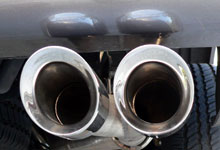
FordMuscle Staff
Many of you already know that the Big
& Ugly Work Truck threw a rod a couple months ago. I
made the decision it was time to stop driving a beater truck
and get a decent daily driver. So I added a new 2006 F150 to
the FordMuscle fleet. It has a 4.6L 2V engine which the factory
gives a flywheel rating of 231 horsepower and 293 lb.ft. of
torque at at 4750 rpm and 3,500 rpm respectively. These aren't
bad numbers...for a Mustang. Double the weight and frontal area
and there is something left to be desired.
American Muscle
Let those horsies run and hear your truck roar with an F150 exhaust system for your Ford truck! So we immediately embarked on getting some more power to move
this rig. The fundamentals of modifying a modern truck are of-course
no different than the approach for a modern car. However, rather
than extending the RPM range for higher top end horsepower,
we are seeking gains across the mid-range. It's this "area
under the curve" that will make the biggest impact on a
truck that is used for towing, hauling and daily driving.
In this article we concentrate on two easy pickings: freeing
up horsepower via a less restrictive exhaust system, and performance
tuning the factory EEC-V processor. (Ok, we'll admit that our
motivation for the exhaust system is rooted more in making the
truck sound and look better.) On the otherhand the Superchips
tuner is purely for power gains.
Exhaust System
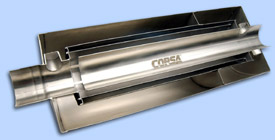
| A look inside a Corsa
muffler. Exhaust gasses flow unrestricted via
the straight-thru pipe. Sound pressure waves escape
into the specifically tuned "maze" where
they are reflected back to cancel out offending
frequencies. |
|
There is no point in owning a V8 if it isn't going to sound
like one. The stock F150 exhaust note is asthmatic, however
we didn't want to go overkill with a muffler that would create
too much interior resonance. After all, Ford did design the new
F150 interior with car-like quiteness.
After doing some research on exhaust system for the F150 we
noticed that Corsa Performance, a household name for Viper and
Vette guys, had extended their offerings into the Ford arena.
Lucky for us F150 and Mustang guys as this is where they put
their efforts. If you have ever heard (and secretly admired)
that crisp and burbley exhaust note from a Corvette, it is likely
the owner had Corsa's patented reflective sound cancellation
technology under the car. Corsa mufflers are engineered to cancel
out exhaust sound frequencies that aren't acoustically appealing
(See side bar for an explanation.) In fact they have actually
patented
this technology. The cost of a Corsa kit is certainly higher
than most exhaust kits, but that is entirely due to the quality.
These kits are all 304 grade stainless steel with flawless welds.
As you can hear in the videos the sound is not like any thing
else on the market.
Exhaust Power Gains
We made a baseline dyno run before the exhaust upgrade. The
F150 put down a peak of 209 horsepower at 5000 rpm and 239 ft.lbs.
of torque at 4400rpm. We had to make the pulls in 2nd gear due
to the automatic wanting to downshift at wide-open throttle
in drive. Also, we later learned, the F150 speed limiter is
set at 100mph. We stopped each pull at 5000 rpm.
The Corsa Performance exhaust stepped up 8HP over stock at the
5000 rpm and torque was up a couple of digits at 4400rpm. However
between 3500 and 4000 rpm we measured the Corsa at as much as
13 ft.lbs. over the stock exhaust system. Both the baseline
and Corsa pulls reflect the factory computer program.
Dyno Results
2006 F-150 (4.6L - Auto)
Advanced Dyno Services, Suisun CA (707) 425-DYNO |
DynoJet Research
72.41°F, 30.03 in-Hg, Humidty 34%, SAE: 0.97
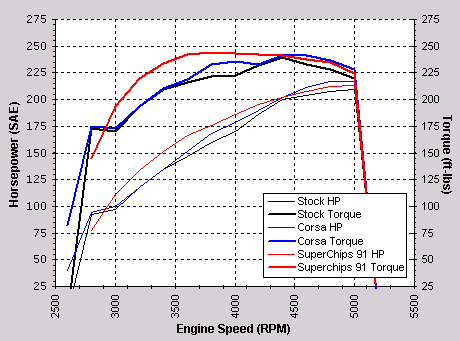
|
Superchip Flashpaq Gains
The next step was to install the Superchips Flashpaq tune. The
Flashpaq comes with two performance tunes depending on whether
you are running 87-octane or 91-octane. Naturally the 91-octane
tune has a more aggressive timing curve hence the need for higher
octane fuel to prevent detonation. The third tune available
on the Flashpaq tuner is a towing program. The tunes vary paramaters
such as timing, fuel curve, shift point and firmness.
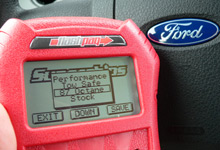
 You've got three tuning options with the F150 Superchips
Flashpaq. The Performance tune requires 91-octane fuel
and rewards you with significant gains in horsepower and
torque all across the power band. The 87-octane tune plays
it safe and bumps up power at more conservative level.
A Towing tune bumps up low and mid-range torque.
You've got three tuning options with the F150 Superchips
Flashpaq. The Performance tune requires 91-octane fuel
and rewards you with significant gains in horsepower and
torque all across the power band. The 87-octane tune plays
it safe and bumps up power at more conservative level.
A Towing tune bumps up low and mid-range torque. |
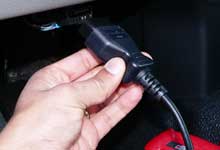
 The Flashpaq uses the OBD-II port under the dash (driver-side)
to connect to the vehicles computer. Follow the on-screen
commands and the tune is on in under 3 minutes. Once you
put a tune on the vehicle the unit is "married"
to that VIN until you re-install the stock tune.
The Flashpaq uses the OBD-II port under the dash (driver-side)
to connect to the vehicles computer. Follow the on-screen
commands and the tune is on in under 3 minutes. Once you
put a tune on the vehicle the unit is "married"
to that VIN until you re-install the stock tune. |
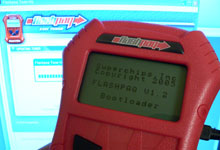
 Superchips has really tapped into the power of the internet
with the Flashpaq. As an owner of a Flashpaq you can register
on flashpaq.com
and then connect your unit via USB to your computer to
recevie updates, custom tunes, etc.
Superchips has really tapped into the power of the internet
with the Flashpaq. As an owner of a Flashpaq you can register
on flashpaq.com
and then connect your unit via USB to your computer to
recevie updates, custom tunes, etc. |

 The Flashpaq has a built in OBD code-scanner as well to
help diagnose any check-engine lights. The units also
have data-logging capability so you can monitor all the
sensors and parameters the factory computer is receiving.
This feature is due out soon for the F150 and would be
downloadable from flashpaq.com
The Flashpaq has a built in OBD code-scanner as well to
help diagnose any check-engine lights. The units also
have data-logging capability so you can monitor all the
sensors and parameters the factory computer is receiving.
This feature is due out soon for the F150 and would be
downloadable from flashpaq.com |
We found the best performane with the 91-octane tune loaded
into our F150s computer. As you can see on the dyno graph above
(red lines) the Flashpaq 91-octane tune gained huge horsepower
and torque throughout the power band. Compared to the factory
tune the Flashpaq unleashed 16-19 horsepower right in the meat
of the power curve between 3000 and 4000 rpm. Torque was up
as much as 26 ft.lbs. The 87-octane tune (not shown on the chart)
showed substatially less gains in the mid-range, but similar
gains on the order of 5-8 horsepower above 4500 rpm. Continue |

(Corsa Exhaust Installation) |
|
|
|
|
|
|
|

